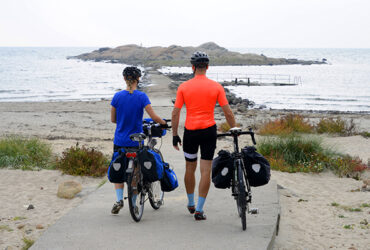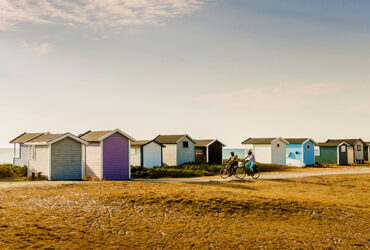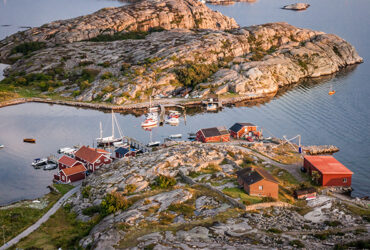Our cycling holidays in Sweden
Cycling adventures along the Swedish coastline
This cycling trip in Sweden is a true ode to the sea, an immersive experience that lets you connect with nature and discover the hidden gems of this Nordic country. Each stop along the Swedish coastline offers unique discoveries, whether you’re sampling fresh seafood in small fishing villages, exploring unspoilt nature reserves or simply relaxing on the beautiful beaches of the Swedish coast.
Discover Sweden by bike
Välkommen till Sverige. Welcome to Sweden. Sweden is a country that beckons adventure. With an area almost the size of France, Sweden stretches south-north for more than 1,500 kilometres, making it the largest and most populous of the Scandinavian countries.
For the convenience of cyclists, the country is criss-crossed by 4 European cycle routes and numerous national cycle paths, particularly in the southern part of the country. This is the case, for example, of the Kattegattleden, which links Helsingborg to Göteborg and was voted cycle route of the year in 2018. On the other hand, the northern part of the country has less cycling infrastructure. The network of roads and paths is sparse, and cyclists have to ride alongside vehicles on certain roads. While the south of the country is accessible to all travellers, the far north is better suited to experienced cyclists.
Cycling in Sweden means discovering a range of wild landscapes. Over 65% of the country is covered in forest, while lakes, rivers and marshes make up 15%. If you love nature and wide open spaces, Sweden has what it takes. The terrain is varied. Slightly hilly in the south and east of the country, it is more pronounced in the western part where the Scandinavian Alps stand. In Lapland, Kebnekaise rises to an altitude of 2,099 metres, making it Sweden’s highest peak.
With 11,500 kilometres of coastline, Sweden wouldn’t be Sweden without its coastline. From the Gulf of Bothnia to the Kattegat and the Baltic Sea, the Swedish coastline offers a wide range of landscapes. Sandy and adorned with shifting dunes on the shores of Skåne in the south, more rocky and jagged along the west coast and in the north. There are more than 220,000 islands off the coast, making for a timeless getaway.
Cycling in Sweden also means wandering around the country’s most beautiful cities on the many cycle paths that criss-cross them. From Stockholm to Gothenburg, via Malmö, Uppsala, Helsingborg and Kalmar, take the pulse of Swedish cities. Castles such as Drottningholm or Kalmar, gardens (Rosendals Trädgård in Stockholm or the botanical garden in Göteborg), cathedrals and museums provide an opportunity to learn more about Sweden’s history and traditions.
The country and its people
Heirs of the Vikings, the Swedes are progressive on the subject of human rights and love contact with nature, which in Sweden is never far away.
Three examples:
- In 1974, Sweden was the first country in the world to grant parental leave to both mothers and fathers. Today it has one of the most generous parental leave systems, allowing parents to stay with their child for 480 days, or 16 months, of which 90 days are allocated to each parent.
- During the 2015 migration crisis, Sweden was the European country that welcomed the most migrants.
- Since 1994, Sweden, like Norway, Finland and Estonia, has had what is known as a right of access to nature: allemansrätt in Swedish. Under certain conditions (respecting nature, not polluting, etc.), people can enjoy nature and its fruits, independently of any property rights that may be attached to them, and without the owner’s prior consent. This right is enshrined in the Swedish constitution.
Like their Danish and Norwegian neighbours, the Swedes tend not to take things too seriously. They try to reconcile their professional and personal lives as much as possible. They like to share a coffee with friends or colleagues during fika, the Swedish custom par excellence. They also enjoy going out into the countryside, never far away, to pick the berries that line the undergrowth, fish or hunt.
The word lagom epitomises the Swedish state of mind. More than an art of living, lagom is a philosophy that advocates sobriety and moderation in everyday life. “Living better with less” could be the definition of lagom.
Sometimes cold at first sight, Swedes usually turn out to be friendly and welcoming once the ice has been broken. They are also pragmatic and will be happy to help you if you need it.
Cycle routes in Sweden
Sweden is criss-crossed by 4 EuroVélo routes:
- EuroVélo 3: the Pilgrims’ Cycle Route. On a European scale, it links Trondheim in Norway to Santiago de Compostela in Spain. In Sweden, EuroVélo 3 runs along the west coast between the Norwegian border and the city of Göteborg.
The route runs between the crenellated Kattegat coastline and the interior, between forests and lakes. - EuroVélo 7: the sunshine cycle route. This allows travellers to reach Malta from the North Cape in Norway. In Sweden, it crosses the entire country. From the wilds of Lapland beyond the Arctic Circle to the beaches of Sweden’s south-west coast, this route gives travellers a complete overview of Sweden.
- EuroVélo 10: the Baltic cycle route. As its name suggests, this EuroVélo route takes you around the Baltic Sea. In Sweden, EuroVélo 10 stretches over 2,500 kilometres. The landscapes are varied and wild: jagged coastlines, romantic islands, crystal-clear lakes and silent forests punctuate the pedal strokes. An ideal route for combining the pleasure of cycling with invigorating swims.
- EuroVélo 12: the North Sea cycle route. It links Bergen in Norway to the Shetland archipelago in Scotland. In Sweden, it criss-crosses the country’s west coast between Göteborg and Halmstad on the Kattegattleden cycle route, voted “Cycle Route of the Year” in 2018. A signposted, safe and relaxing route by the sea.
Swedish weather
Because of its northern latitude, Sweden enjoys a climate that varies from season to season. The four seasons are very marked and the Swedes are very proud of this: “In Sweden, we have 4 real seasons”, as they like to say.
Dark, cold, even icy and snowy, especially in the north, winter is long and lasts from November to the end of April. It’s the ideal time to see the famous Northern Lights dancing in the northern sky. Less so for cycling! Summer lasts about 2 months, from mid-June to the end of August. The days are long and bright. Depending on the year and the region of Sweden, it can even be hot, up to 30-35°C. Beyond the Arctic Circle, in Lapland, the sun doesn’t set for several weeks. This is known as the midnight sun. Between winter and summer, spring and autumn are brief but marked.
The ideal time to cycle in Sweden is between May and September. In the south of Sweden, where we stay, the days are long and the average temperature fluctuates between 15 and 20°C during this period. Rain is not uncommon, but sunny days are also common. At the height of summer, sea temperatures can rise to 20°C on the beaches of Sweden’s south and west coasts. Ideal for cooling off after a day’s cycling.
Neither too hot nor too cold, the Swedish climate offers ideal conditions for cycling from late spring to early autumn.
The 8 must-sees in Sweden
As the largest country in Scandinavia, Sweden is full of sites of natural and cultural interest to discover. To guide you, we recommend
- Stockholm, the Swedish capital.
- Sarek National Park, the last wilderness in Europe.
- The Gothenburg archipelago, a timeless getaway.
- The megaliths of Ale, along the southern coast of Skåne.
- Fjällbacka, a fishing village on the Bohuslän coast, well known to fans of Nordic thrillers.
- Kalmar Castle, a key place in the history of Scandinavia.
- The island of Gotland, a cyclist’s paradise.
- Admire the Northern Lights from Abisko National Park.

 Fit
Fit

 Leisure
Leisure